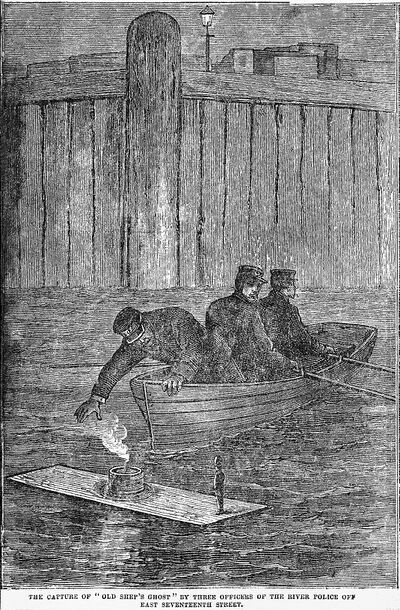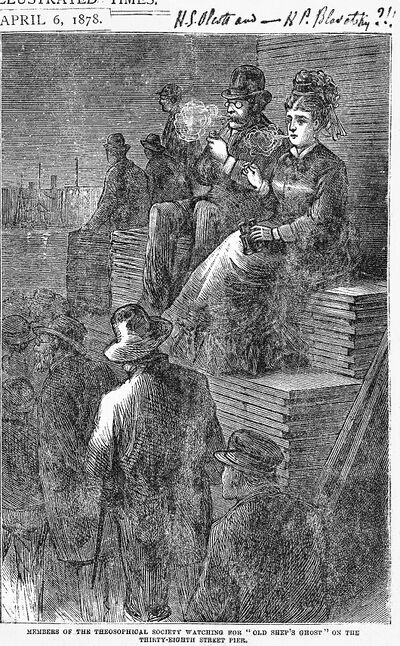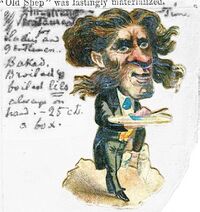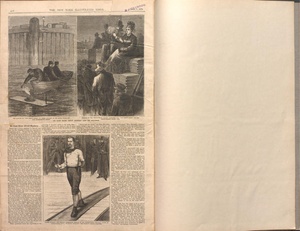The Capture of " Old Shep's Ghost " by Three Officers of the River Police off East Seventeenth Street |
Members of The Theosophical Society Watching for " Old Shep's Ghost " on the Thirty-Eighth Street PierH.S. Olcott and – H.P. Blavatsky?!!
|
An East River Ghost Mystery
There was a lively sensation in this city last week over the discovery of what was reported to be a genuine ghost. The fact that the apparition was vouched for by a number of policemen who ought to be the last to be deceived on such a subject, and was gravely watched for by some leading members of the Theosophical Society seemed to give importance to the mysterious event, and for a time there was no little excitement and curiosity in regard to it all along the East River front.
About a month ago a night-watchman, named Joseph B. Sheppard and familiarly known as "Old Shep," was found drowned in the East River at the foot of Thirty-eighth Street, near which place his beat had been. Soon after it was reported that he or his spirit had been seen walking his old beat as naturally as when alive. Officer Thomas Kilbride of the Twenty-first Precinct was certain that he had seen the ghost one night while he was on duty, and that it faded into thin air when spoken to.
The ghost had also been seen, as was certified by many persons, in the shape of a cadaverous human figure, emitting a brilliant but unearthly light, and hovering above or floating upright on the river.
Officer Kilbride said that he had himself seen the wonderful light about the pier at midnight. He described it as about double the size of the light of a street-lamp, flying about on the edge of the water at midnight, then making suddenly for the middle of the river and disappearing. The officer was as positive about the man and the light as possible. He has been on the force a long time, and Captain Murphy says that he is a brave man.
While the excitement over these mysteries was at its height, the two leading spirits of the Theosophical Society—Colonel H. S. Alcott and Mme. Blavatsky—determined to make an investigation. They drove in a carriage to the Thirty-first Precinct Police Station, and from thence, accompanied by Captain Murphy and half a dozen reporters, they drove to the wharf.
At 11:50 the party reached the haunted pier, and in a few minutes a great crowd had collected. None of the neighboring watchmen, however, could be coaxed to approach the spot. It is a fine place for a ghost-walk. A narrow lane, between two great rows of tall lumber piles, leads from the street to the river-side. The bank, which is washed into drifts and tunnels, runs abruptly down to the wharf, which is eight or ten feet lower than the surrounding ground. All around are tall lumber piles. On the left, jutting out from the wharf, is the skeleton of an old pier, about twenty feet square. The planking long ago decayed and dropped off, and the timbers only are left. It was under this skeleton pier that the body of the watchman was found lying upon its face on a great rock, the back of the head entirely out of the water. His hat lay upon the bank. It is from under the old pier, too, that the lights are said to have come.
When questioned about her experience in the returning of departed spirits to the earth, Mme. Blavatsky replied that the spirits of men of great genius might return to invest the spirits or souls of their friends.
“But this man was not a genius,” was replied. “He was a decrepit old man, and a bummer.”
“That is just reason,” said Mme. Blavatsky, deftly rolling a cigarette between her fingers and lighting it, “why his spirit returns in this shape. If he had been possessed of a great mind, he would not have returned in bodily shape; he would have come mentally. You mustn’t laugh while you’re waiting for the ghost,” Mme. Blavatsky continued. “Seriously, you never can see any spirits when you laugh. This is a good night for a phenomenon. The moon helps it, and it is dry. You never can see any sights on a wet night.”
Col. Olcott improvised a seat, from one of the lumber piles, lit his pipe, and smoked a way patiently. Mme. Blavatsky kept him company with the cigarettes.
The ghost, however, insisted upon not coming out from under the wharf, and it kept itself shaded from mortal eyes that night. It was one o'clock in the morning when the party left the wharf, and it was as ghostless and chilly a party as ever hunted an ignis fatuus.
The night after this unrewarded vigil of the Theosophs three officers of the river police, Mints, McCarthy, and Parks, lay in wait in a little boat at the foot of Thirty-fourth Street and saw the mysterious beacon dancing on the water.
Officer Parks thought that the light ought to be captured, and the rowboat was pulled silently and as swiftly as possible to the dancing beacon. It was a stern chase. Now and then the light disappeared, and then in a second or two showed itself as bright as ever. It seemed to float upon the waves. By hard pulling they gradually gained upon the light, and at last came within a few feet of it. This kind of a chase was kept up for some time.
At length the three river policemen got the strange thing cornered off the pier at East Seventeenth Street. Officer Parks stood in the bow of the rowboat, leaning over. Then he suddenly reached forward with a lurch that almost upset the rowboat. His hand touched something cold and clammy, which he grasped, and the next instant he had “Old Shep’s” ghost in the little rowboat.
Officer Kilbride was right in saying that at times the light showed the form of a man behind it. There is such a form. It stands about twelve inches back of the light, wears a grenadier cap, very black and heavy, has a ferocious expression on the face, which is very pale, has on a red coat and striped trousers, and holds one arm up as if in salute. The lamp appears to have done service on some night-vender’s stand. It is tin, filled with kerosene, and is fastened to a thin board, which is broad enough to ride on the water without upsetting.
Probably the boys who rigged it all up and set it afloat from the foot of Thirty-fifth Street near the spot where “Old Shep” was drowned, anticipated the effect which its discovery by Officer Kilbride or any one else in the vicinity would cause. The tide had carried it back and forth, one night through the Rips, and once it narrowly escaped landing near the wharf of the Mutual Gas Light Company, where is much inflammable matter. The waves of the ferryboat Maryland upset the raft Tuesday night, but the boys went out in a boat soon afterward and recovered it. Thus, by three brave policemen, the ghost of “Old Shep” was lastingly materialized.
Editor's notes
- ↑ The Capture of " Old Shep's Ghost " by Three Officers of the River Police off East Seventeenth Street by unknown author, New York Illustrated Times, The, April 6, 1878
- ↑ Members of The Theosophical Society Watching for " Old Shep's Ghost " on the Thirty-Eighth Street Pier by unknown author, New York Illustrated Times, The, April 6, 1878
- ↑ An East River Ghost Mystery by unknown author, New York Illustrated Times, v. 3, No. 78, April 6, 1878, p. 416
- ↑ image by unknown author. colored waiter




